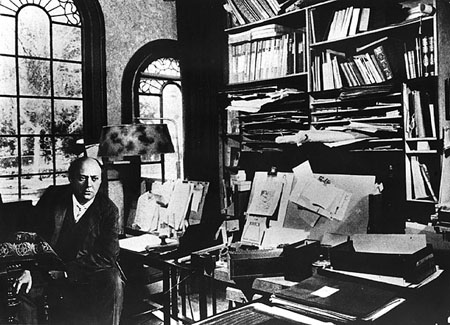 Arnold (Franz Walter) Schoenberg (also spelled Schönberg) was born in Vienna, son of a shoe shop keeper and a mother who used to give piano lessons. Schoenberg began to compose musical pieces for violin already at the age of nine. He studied various musical instruments, especially the cello and at the same time continued to compose a range of musical pieces, especially string quartets.
Arnold (Franz Walter) Schoenberg (also spelled Schönberg) was born in Vienna, son of a shoe shop keeper and a mother who used to give piano lessons. Schoenberg began to compose musical pieces for violin already at the age of nine. He studied various musical instruments, especially the cello and at the same time continued to compose a range of musical pieces, especially string quartets.
From 1890 to 1895, following his father’s untimely death, Schoenberg worked as a bank clerk in order to sustain his family. In 1901 he moved to Berlin, where he worked as musical director of the Ueberbrettl, an artistic cabaret. He returned to Vienna in 1903, when he met Gustav Mahler, who became one of his main supporters. In Vienna he worked as a teacher, his students included the Austrian composers Alban Berg and Anton Webern. It was during his stay in Vienna in the 1900s that Schoenberg pioneered a new method of composition based on a row, or series, of 12 tones, that became known as atonality. His piano piece Opus 11, Nr. 1, finished in 1909, is considered to be the first composition that totally disregarded the tonal methods. In 1911 Schoenberg moved again to Berlin, where he was a composition teacher at the Stern Conservatory, and remained there until 1915, when he returned to Austria for the military service during WW1, from which he was discharged in 1917 because of medical reasons.
After WW1 Schoenberg spent his time between Vienna and Berlin, where he was a teacher at the Prussian Academy of Arts, after 1925.
The rise to power of the Nazis in 1933 forced him to leave Germany and to immigrate to the USA, after a short sojourn first in Spain, and then in Paris. The same year Schoenberg returned to Judaism, which he had abandoned earlier in his life, in solidarity to the anti-Jewish persecutions in Nazi Germany. In the USA he first worked at the Malkin Conservatory in Boston (1934), but soon afterwards he moved to California. Schoenberg held major teaching positions at the University of Southern California, from 1935 to 1936, and at the University of California at Los Angeles, from 1936 to 1944. Arnold Schoenberg died in Los Angeles in 1951.
Schoenberg’s major compositions include: Verklaerte Nacht (“Transfigured Night”) (1899), Pelleas und Melisande (1902-1903), Chamber Symphony in E Major (1906), Pierrot Lunaire (1912), Die glueckliche Hand (“The Hand of Fate”) (1924), Moses und Aron (unfinished, 1930), Von Heute auf Morgen (“From Today to Tomorrow”) (1928-1929), Begleitmusik zu einer Lichtspielszene (“Accompaniment to a Film Scene”) (1929-1930), Violin Concerto, Opus 36 (1934-1936), Piano Concerto, Opus 42 (1942), and Fantasia (1949). During his later years, Schoenberg also composed a number of pieces inspired from the Jewish tradition and the Holocaust, including Kol Nidre (1938), Prelude to the Genesis Suite (1945), A Survivor of Warsaw (1947), and Moderne Psalmen (1950), set to his own texts.
In addition, Schoenberg wrote a number of important textbooks about his musical method: Harmonielehre (“Theory of Harmony”) (1911), Models for Beginners in Composition (1942), and Fundamentals of Musical Composition (1967).